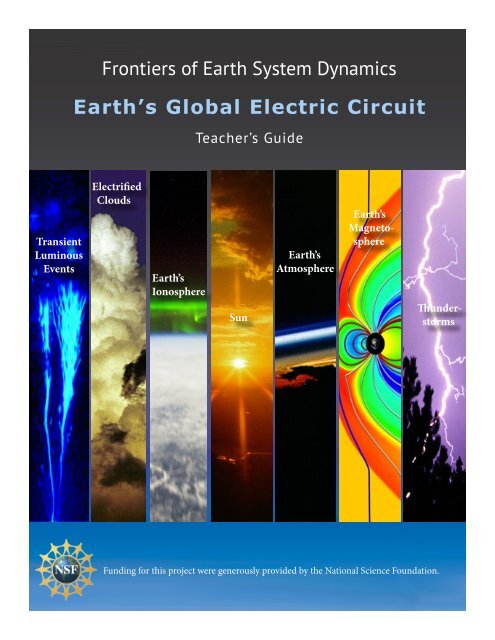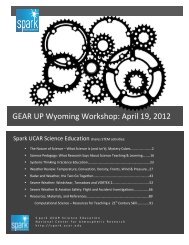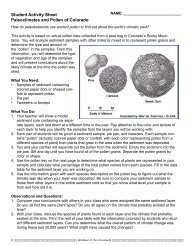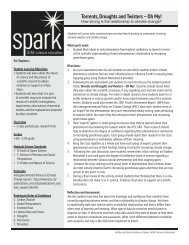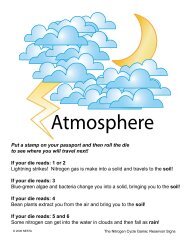Earth's Global Electric Circuit - Spark - University Corporation for ...
Earth's Global Electric Circuit - Spark - University Corporation for ...
Earth's Global Electric Circuit - Spark - University Corporation for ...
Create successful ePaper yourself
Turn your PDF publications into a flip-book with our unique Google optimized e-Paper software.
Frontiers of Earth System Dynamics<br />
Earth’s <strong>Global</strong> <strong>Electric</strong> <strong>Circuit</strong><br />
Teacher’s Guide<br />
Transient<br />
Luminous<br />
Events<br />
Electrified<br />
Clouds<br />
Earth’s<br />
Ionosphere<br />
Sun<br />
Earth’s<br />
Atmosphere<br />
Earth’s<br />
Magnetosphere<br />
Thunderstorms<br />
Funding <strong>for</strong> this project were generously provided by the National Science Foundation.
Table of<br />
Contents<br />
T A B L E O F C O N T E N T S<br />
Frontiers of Earth System Dynamics: Earth’s <strong>Global</strong> <strong>Electric</strong> <strong>Circuit</strong><br />
GLOBAL ELECTRIC CIRCUIT VIDEO.................................................................. 2<br />
Overview and Teacher’s Guide......................................................................... 3<br />
EARTH’S ELECTRIFIED ATMOSPHERE<br />
Earth’s <strong>Global</strong> <strong>Electric</strong> <strong>Circuit</strong>.......................................................................... 4<br />
Earth’s Sun....................................................................................................... 6<br />
Earth’s Magnetosphere.................................................................................... 7<br />
Earth’s Atmosphere.......................................................................................... 8<br />
Earth’s Ionosphere........................................................................................... 10<br />
Transient Luminous Events (TLEs)................................................................... 12<br />
Earth’s Clouds.................................................................................................. 14<br />
.<br />
Earth’s Lightning and Electrified Stoms......................................................r.. 15<br />
ACTIVITIES........................................................................................................ 17<br />
Educational Sites ....................................................................................... 18<br />
MEET THE SCIENTISTS..................................................................................... 20<br />
<strong>Spark</strong> – UCAR Science Education<br />
spark.ucar.edu<br />
GLOSSARY of TERMS........................................................................................ 23<br />
RESOURCES....................................................................................................... 29<br />
Atmosphere Graphic.................................................................................. 30<br />
© 2012 <strong>University</strong> <strong>Corporation</strong> <strong>for</strong> Atmospheric Research<br />
<strong>Global</strong> <strong>Electric</strong> <strong>Circuit</strong> Graphic................................................................... 31<br />
Recommended Websites ........................................................................... 32<br />
i
Transient<br />
Luminous<br />
Events<br />
G E C V i d e o<br />
Electrified<br />
Clouds<br />
Earth’s<br />
Atmosphere<br />
Earth’s<br />
Magnetosphere<br />
This Booklet and the video that it complements introduce students to a natural system in Earth’s<br />
atmosphere commonly referred to as the <strong>Global</strong> <strong>Electric</strong> <strong>Circuit</strong>. The circuit encompasses the various<br />
phenomena in our atmosphere that influence the many pathways of electricity that flow between Earth<br />
and the atmosphere’s ionosphere: lightning, electrified clouds, cosmic rays, ions, magnetic fields, radon<br />
emanating from beneath Earth’s surface.... These phenomena and more encompass a complex system of<br />
electrical circuits that scientists are just beginning to understand.<br />
The goal of scientific researchers working to advance our basic understanding of the <strong>Global</strong> <strong>Electric</strong><br />
<strong>Circuit</strong> is to develop a model that captures the system’s complexity and immense variability across space<br />
and time. This will allow scientists worldwide to study the system and better understand connections<br />
between Earth’s atmospheric electricity and other components of the Earth system.<br />
Next Generation Science Standards Addressed<br />
Ionosphere<br />
Sun<br />
Thunderstorms<br />
Next Generation Science Standards: Earth Science*<br />
ESS1.B Earth and the solar system<br />
ESS2.A Earth materials and systems<br />
ESS2.D Weather and climate<br />
ESS3.B Natural hazards<br />
ESS3.C Human impacts on Earth systems<br />
Next Generation Science Standards: Physical Science<br />
PS1.A Structure of matter<br />
PS1.B Chemical reactions<br />
PS2.A Forces and motion<br />
PS2.B Types of interactions<br />
PS2.C Stability & instability in physical systems<br />
PS3.A Definitions of energy<br />
PS3.B Conservation of energy and energy transfer<br />
Teacher’s Guide<br />
Next Generation Science Standards: Life Science<br />
LS2.B Cycles of matter and energy transfer in ecosystems<br />
* These standards come from the Next Generation Science Standards – second draft, January 2013<br />
2<br />
3.
Earth’s <strong>Global</strong> <strong>Electric</strong> <strong>Circuit</strong> – It’s difficult to comprehend the<br />
world be<strong>for</strong>e electricity was put to use to power our homes, streets, and<br />
cities over 100 years ago. The truth is though, electricity has always been<br />
with us, just unharnessed <strong>for</strong> human use until relatively recently in human<br />
history.<br />
<strong>Electric</strong>ity extends throughout our atmosphere in what is collectively called<br />
the <strong>Global</strong> <strong>Electric</strong> <strong>Circuit</strong>. In fact, a flash of lightning is not an isolated event<br />
within a thuderstorm. It is part of this vast global circuit, creating a voltage<br />
of current 200,000 to 500,000 volts (200 to 500 kV) between the ground and<br />
the ionosphere. Thunderstorms alone send 1 amp (A) of current skyward. But<br />
the circuit courses through the atmosphere even on fair-weather days when a<br />
slight current of 2 picoamps (or 0.0000000000002 A) flows from every square<br />
meter of ground upward to the ionosphere.<br />
Earth’s<br />
<strong>Global</strong><br />
<strong>Electric</strong><br />
<strong>Circuit</strong><br />
We are all aware of lightning flashes, and the tremendous power that they can transfer from<br />
electrical clouds to Earth’s surface in the <strong>for</strong>m of electric current. But did you know that millions<br />
of lightning flashes occur per day over the Earth? That lightning discharges also occur between<br />
the clouds and the edge of space, producing luminous displays called sprites and elves? Did you<br />
know hat cosmic rays from other galaxies and x-rays from the Sun make the edge of space electrically-conducting<br />
so that these events can occur; that currents in the ionosphere can induce<br />
dangerous current surges in our power grid system; that lightning emits powerful electromagnetic<br />
radiation; or that the signatures of interactions between charged particles from the<br />
Sun and Earth’s outer magnetic field can be measured at the ground in the polar regions?<br />
How might lightning modify ionospheric conditions that affect communications and navigation<br />
(e.g., GPS) systems? How might changes in the space environment affect electrical processes in<br />
polar-region clouds relevant to weather and climate, or how might society be impacted in other<br />
ways through electrical connections within the Earth-atmosphere-geospace system.<br />
The goal of research on the <strong>Global</strong> <strong>Electric</strong> <strong>Circuit</strong> is to create a realistic global model of Earth’s<br />
electrical system from the surface into the ionosphere. It will then be used to better understand<br />
how electric fields, electric currents and magnetic fields are redistributed globally in response to<br />
lightning discharges, electrified clouds, and disturbances in interplanetary space and the geospace<br />
environment. We invite you to join us and learn about the <strong>Global</strong> <strong>Electric</strong> <strong>Circuit</strong>, too!<br />
Scientists have long been interested in understanding various parts of the<br />
<strong>Global</strong> <strong>Electric</strong> Cirucit, but the system is vast and varies over time from<br />
seconds, hours, and days to months, seasons, and decades. and space.<br />
Understanding the system in its entirety is in its beginning stages,<br />
but that doesn’t mean that scientists haven’t been studying its various<br />
components and trying to make sense of them. They’ve been doing so <strong>for</strong> at<br />
least 200 years!<br />
From 1909 to 1929, Carneige, a yacht that was nearly entirely non-magnetic<br />
and wood-hulled, sailed around the world – nearly three-hundred thousand<br />
miles through its oceans – carefully locating and measuring then unknown<br />
magnetic influences in the atmosphere. Its many voyages were part of the<br />
Carneige Institution’s program that included an ambitious magnetic, electric,<br />
and oceanographic survey, coupled with magnetic and electric surveys of land<br />
areas in many parts of the world. Eventually it carefully located and<br />
measured unknown magnetic influences in the atmosphere, and gave<br />
scientists the Carneige Curve, the characteristic and universal variation of<br />
Earth’s atmospheric electric field, which is still used today.<br />
Scientists at the National Center <strong>for</strong> Atmospheric Research, the <strong>University</strong> of<br />
Colorado, Penn State, and elsewhere around the world are interested in<br />
verifying and quantifying the circuit’s many pathways, sources, and<br />
influences in order to build a scientific model. This will allow scientists to test<br />
their ideas about how the system works and its impact on and/or connection<br />
with other parts of the Earth system. It may be that Earth’s <strong>Global</strong> <strong>Electric</strong><br />
<strong>Circuit</strong> has profound implications on Earth’s climate or weather. Society will<br />
never know the true role it plays within the Earth system until such a model<br />
is available <strong>for</strong> further exploration, experimentation, and discovery.<br />
On the pages that follow, we invite you to explore the vastness and many<br />
components of the <strong>Global</strong> <strong>Electric</strong> <strong>Circuit</strong> – from lightning and electrified<br />
clouds to influences such as microscopic particles that can interfer with the<br />
conductivity of the atmosphere. to cosmic rays and currents induced from<br />
solar storms from external electrical processes. It’s true that the system is<br />
complex and difficult to unravel and understand in its entirety, but scientists<br />
are well on there way to unlocking its many mysteries.<br />
4. 5.
The<br />
Sun<br />
The Sun provides Earth with energy that makes life on our planet possible.<br />
The Sun gives off electromagnetic energy in many wavelengths, including<br />
radio waves, microwaves, infrared, visible light, ultraviolet, and high energy<br />
x-rays and gamma rays. The Sun also emits a stream of radiation in the <strong>for</strong>m<br />
of charged particles that make up the plasma of the solar wind emitted most<br />
notably during solar storms called coronal mass ejections (CMEs) .<br />
A Coronal Mass Ejection (CME) is an explosive outburst of solar wind plasma<br />
from the Sun. The blast of a CME typically carries roughly a billion tons of<br />
material outward from the Sun at speeds on the order of hundreds of<br />
kilometers per second. A CME contains particle radiation (mostly protons and<br />
electrons) and powerful magnetic fields. These blasts originate in<br />
magnetically disturbed regions of the corona, the Sun’s upper atmosphere -<br />
hence the name. Occasional outbursts from these huge explosions on the Sun<br />
send space weather storms hurtling outward through our solar system. Some<br />
of these storms smash into Earth’s magnetosphere, the protective magnetic<br />
bubble which surrounds our fragile planet. Particle radiation spiralling down<br />
along our planet’s magnetic field lines can damage satellites, disrupt communications<br />
systems, and even short out electrical power systems.<br />
Sunspots are dark, planet-sized regions that appear on the “surface” of the Sun.<br />
A large sunspot might have a central temperature of 4,000 K (about 3,700° C or<br />
6,700° F), much lower than the 5,800 K (about 5,500° C or 10,000° F)<br />
temperature of the adjacent photosphere. Sunspots are only dark in contrast to<br />
the bright face of the Sun. They are caused by disturbances in the Sun’s<br />
magnetic field welling up to the photosphere, the Sun’s visible surface. They<br />
<strong>for</strong>m over periods lasting from days to weeks, and can persist <strong>for</strong> weeks or even<br />
months. The powerful magnetic fields in the vicinity of sunspots produce active<br />
regions on the Sun, which in turn frequently spawn disturbances such as solar<br />
flares and coronal mass ejections (CMEs).<br />
Earth’s Magnetosphere refers to the protective envelope<br />
constantly surrounding our planet where Earth’s magnetic field dominates. It<br />
is created by Earth’s rapidly spinning liquid metal core that results in a<br />
planetary magnetic field similar to a bar magnet’s, with a north and south<br />
pole. It ultimately provides a magnetic shield that protects Earth from energetic<br />
charged particles that bombard Earth during coronal mass ejections<br />
(CMEs).<br />
When CMEs travel outward through the Solar System toward Earth, ions in<br />
the solar plasma interact with Earth’s magnetic field and are swept around it.<br />
In fact, the collision of the solar wind impacts the shape of Earth’s magnetosphere.<br />
On its Sunward side, it becomes compressed to a size six to ten times<br />
the radius of the Earth, and a shock wave, called a bow shock, occurs that is<br />
similar to a sonic boom. This bow shock diverts much of the charged<br />
particles from solar storms around the outer boundry of the magnetosphere.<br />
On the opposite or night-side of Earth’s magnetosphere, the solar wind is<br />
believed to extend the magnetosphere’s magnetic field outward <strong>for</strong><br />
millions of miles (1000 times Earth’s radius). Scientists refer to this impact as<br />
the magnetotail.<br />
During a solar storm, much of the radiation is trapped in three inner and<br />
outer areas within Earth’s magnetic field called the plasmasphere, the ring<br />
current, and the Van Allen Belts. Some highly energetic particles in the Van<br />
Allen Belts will follow the magnetic field lines to Earth’s polar regions and<br />
enter the upper atmosphere. Sometimes, magnetic field lines from<br />
incoming plasma connect with the field lines of the magnetosphere and<br />
catapolt charged particles into it.<br />
Earth’s<br />
Magnetosphere<br />
Historical records of sunspot counts, which go back hundreds of years, verify<br />
that this sunspot cycle has an average period of roughly eleven years,<br />
beginning with few spots during what is referred to as the solar minimum, and<br />
gaining in spots and solar activity as the 11-year cycle progresses.<br />
The disturbance can also trigger a series of events that send a burst of<br />
particle radiation into Earth’s upper atmosphere. As the radiation crashes into<br />
gas molecules in Earth’s atmosphere, it causes them to glow... creating the<br />
magnificent light shows of the auroras (the Northern Lights and Southern<br />
Lights).<br />
In terms of Earth’s <strong>Global</strong> <strong>Electric</strong> <strong>Circuit</strong>, the Sun is central to its existence.<br />
It provides most of the ionizing radiation that produces ions (charged atoms)<br />
within Earth’s atmosphere, especially in its upper layers and regions,<br />
including the aptly named ionosphere. This is especially true during cornal<br />
mass ejections that head Earth’s way.<br />
First, high-energy sunlight, mostly x-rays and ultraviolet light, ionizes Earth’s<br />
upper atmosphere. Next comes a radiation storm. Finally comes the coronal<br />
mass ejection, a slower moving cloud of charged particles that can take<br />
several days to reach Earth’s atmosphere. When a CME hits, the solar particles<br />
can interact with Earth’s magnetic field to produce powerful electromagnetic<br />
fluctuations. They alsocause auroras, or the northern and southern lights,<br />
mostly seen near Earth’s Poles, where charged particles in the solar wind<br />
collide with atmospheric gases.<br />
NASA’s Magnetospheric Multiscale Mission (MMS) and Radiation Belts Storm<br />
Probe Mission (RBSP) will help scientists better understand and model<br />
magnetosphere processes and their impact on Earth’s <strong>Global</strong> <strong>Electric</strong> <strong>Circuit</strong>.<br />
At right, two illustrations<br />
of the same Cornal Mass<br />
Ejection on the Sun. The<br />
first image represents the<br />
start of the Coronal Mass<br />
Ejection, while the second<br />
image captures the solar<br />
storm as it magnifies and<br />
explodes into space.<br />
6. 7.
Earth’s<br />
Atmosphere<br />
Earth’s atmosphere is a mixture of gases that surrounds our home<br />
planet. Besides providing us with something to breathe, the atmosphere helps<br />
make life on Earth possible in several ways. It shields us from most of the<br />
harmful ultraviolet (UV) radiation coming from the Sun, warms the surface of<br />
our planet by about 33° C (59° F) via the greenhouse effect, and largely<br />
prevents extreme differences between daytime and nighttime temperatures.<br />
The atmosphere grows thinner (less dense and lower in pressure) as one moves<br />
upward from Earth’s surface. It gradually gives way to the vacuum of outer<br />
space. There is no precise “top” of the atmosphere. Air becomes so thin at<br />
altitudes between 100 and 120 km (62-75 miles) up that <strong>for</strong> many purposes<br />
that range of heights can be considered the boundary between the atmosphere<br />
and space. However, there are very thin but measurable traces of atmospheric<br />
gases hundreds of kilometers/miles above Earth’s surface.<br />
There are several different regions or layers in the atmosphere. Each has characteristic<br />
temperatures, pressures, and phenomena. We live in the troposphere,<br />
the lowest layer. Most of the mass (about 75-80%) of the atmosphere is in the<br />
troposphere. Clouds, too, are found in the troposphere, and almost all weather<br />
occurs within this layer. It extends upward to about 10 km (6.2 miles or about<br />
33,000 feet) above sea level.<br />
Some jet aircraft fly in the next higher layer, the stratosphere, which contains<br />
the jet stream and the ozone layer. A rare type of electrical discharge, somewhat<br />
akin to lightning, occurs in the stratosphere. These blue jets appear above<br />
thunderstorms, and extend from the bottom of the stratosphere up to altitudes<br />
of 40 or 50 km (25 to 31 miles).<br />
Although the thermosphere is considered part of Earth’s atmosphere, the air<br />
density is so low in this layer that most of the thermosphere is what we<br />
normally think of as outer space. In fact, the most common definition says<br />
that space begins at an altitude of 100 km (62 miles). The space shuttle and<br />
the International Space Station both orbit Earth within the thermosphere!<br />
High-energy solar photons also tear electrons away from gas particles in the<br />
thermosphere, creating electrically-charged ions of atoms and molecules.<br />
Earth’s ionosphere, composed of several regions of such ionized particles in<br />
the atmosphere, overlaps with and shares the same space with the electrically<br />
neutral thermosphere. Moving ions, dragged along by collisions with<br />
the electrically neutral gases, produce powerful electrical currents in some<br />
parts of the thermosphere.<br />
Finally, the aurora (the Southern and Northern Lights) primarily occur in the<br />
thermosphere. Charged particles (electrons, protons, and other ions) from<br />
space collide with atoms and molecules at high latitudes, exciting them into<br />
higher energy states. Those atoms and molecules shed this excess energy by<br />
emitting photons of light, which we see as colorful auroral displays.<br />
Earth’s atmosphere gradually fades into the vacuum of space. Since the exosphere<br />
gradually fades into outer space, there is no clear upper boundary or<br />
top. The outermost limit of the atmosphere’s uppermost edge occurs in the<br />
region around 190,000 km (120,000 miles), about halfway to the Moon.<br />
Earth’s<br />
Atmosphere<br />
Higher still is the mesosphere. This layer is directly above the stratosphere. It<br />
extends from about 50 to 85 km (31 to 53 miles) above our planet. Odd<br />
electrical discharges akin to lightning called sprites and elves, occasionally<br />
appear in the mesosphere dozens of kilometers (miles) above thunderclouds in<br />
the troposphere below. The stratosphere and mesosphere together are<br />
sometimes referred to as the middle atmosphere.<br />
The thermosphere is directly above the mesosphere. It extends from about<br />
90 km (56 miles) to between 500 and 1,000 km (311 to 621 miles) above our<br />
planet. Temperatures climb sharply in the lower thermosphere (below 200 to<br />
300 km altitude or 124 to 186 miles), then level off and hold fairly steady with<br />
increasing altitude above that height.<br />
Solar activity strongly influences temperature in the thermosphere. It is<br />
typically about 200° C (360° F) hotter in the daytime than at night, and<br />
roughly 500° C (900° F) hotter when the Sun is very active than at other<br />
times. Temperatures in the upper thermosphere can range from about 500° C<br />
(932° F) to 2,000° C (3,632° F) or higher. This is especially true during a<br />
period called the solar maximum, the period of greatest solar activity in its<br />
~11 year solar cycle.<br />
8.<br />
9.<br />
At Left: The depth to which<br />
particles penetrate the<br />
atmosphere depends on their<br />
energy; the more energetic<br />
they are, the deeper they travel.<br />
Cosmic rays can reach the troposphere or even the surface of the<br />
Earth; solar energetic particles and radiation belt particles can<br />
reach the stratosphere and mesosphere; and auroral particles<br />
reach the lower thermosphere, usually to around 62 miles or<br />
100 kilometers. Auroral particles entering the atmosphere are far<br />
more numerous than the others, which is why auroral displays<br />
are seen.<br />
Source: The COMET Program
Earth’s<br />
Ionosphere<br />
The Ionosphere - Earth’s atmosphere contains a series of regions that<br />
have a relatively large number of electrically charged atoms and molecules.<br />
As a group, these regions are collectively called the ionosphere and they<br />
extend from about 35 to more than 1,000 miles above Earth’s surface<br />
(56 to 1610 km) from the middle of the mesosphere through the entire<br />
thermosphere and further.<br />
Interestingly, the existence of an electrically-conducting region of the<br />
atmosphere was not confirmed until the first decade of the 20th Century. Its<br />
discovery ushered in the long-distance transmission of radio waves by the<br />
ionosphere’s reflective properties, which acts like a mirror in the sky making<br />
the transmission of radio waves possible.<br />
The ionosphere is made up of three horizontal regions commonly referred<br />
to as regions D, E, and F. Region D extends from approximately 40 to 60<br />
miles (64 to 96 km); Region E extends from 60 to 80 miles (96 to 129 km);<br />
and Region F extends from about 100 to 1,000 miles (160 to 1610 km) or<br />
more above Earth’s surface. The ionosphere reaches its maximum density of<br />
charged particles in this last region, Region F, from 125 to 375 miles (201 to<br />
603 km) altitude. It then decreases in density with height.<br />
It is in constant flux over time and place in both its charged particle density<br />
and its structure. Its variability is due to the variability of the Sun. Not only<br />
does the Sun’s energy change throughout a 24-hour period, the Sun’s x-ray<br />
and ultraviolet emissions also change and impact the ionosphere due to the<br />
Sun’s highly variable 11-year sunspot cycle, changes in the Sun’s<br />
rotation, solar flares, and more. The ionosphere not only varies greatly with<br />
time (sunspot cycle, seasonally, and diurnally), but also by geographical<br />
location (polar, auroral zones, mid-latitudes, and equatorial regions), and with<br />
certain solar-related ionospheric disturbances.<br />
The ionosphere is that part of the upper atmosphere where free electrons<br />
occur in sufficient density to have an appreciable influence on the<br />
propagation of radio frequency electromagnetic waves. This ionization<br />
depends primarily on the Sun and its activity. Ionospheric structures and<br />
peak densities in the ionosphere vary greatly with time (sunspot cycle,<br />
seasonally, and diurnally), with geographical location (polar, auroral zones,<br />
mid-latitudes, and equatorial regions), and with certain solar-related<br />
ionospheric disturbances.<br />
The major part of the ionization is produced by solar X-ray and ultraviolet<br />
radiation, and by radiation from the solar wind of the Sun and space rays.<br />
The most noticeable effect is seen as the Earth rotates with respect to<br />
the Sun; ionization increases in the sunlit atmosphere and decreases on<br />
the shadowed side. Although the Sun is the largest contributor toward<br />
the ionization, cosmic rays make a small contribution. Any atmospheric<br />
disturbance affects the distribution of the ionization.<br />
The ionosphere is a dynamic ever-changing system controlled by many<br />
things including acoustic motions of the atmosphere, electromagnetic<br />
emissions, and variations in the geomagnetic field. Because of its extreme<br />
sensitivity to atmospheric changes, the ionosphere is a very sensitive<br />
monitor of atmospheric events. The most accurate way of measuring the<br />
ionosphere is with a ground-based ionosonde, which records data as<br />
ionograms.<br />
Earth’s<br />
Ionosphere<br />
Interestingly, Region F is also an exporter of ions and electrons. Ions are<br />
neutral atoms that have become electrically charged by the addition or loss<br />
of one or more electrons. Electrons are sub-atomic particles within atoms<br />
that carry a negative charge. An atom that gains an electron, there<strong>for</strong>e, is<br />
negative, while an atom that looses an electron is positive. Protons are the<br />
corresponding positively charged particles within all atoms.<br />
As the Sun’s energy reaches the ionosphere in the day, the ionosphere<br />
expands and carries ions upward into an area surrounding our planet called<br />
the magnetosphere. As the Sun sets and night arrives, the ionopshere cools<br />
and contracts, which draws lost ions and electrons back to the ionosphere<br />
until the Sun’s return each dawn. Here, the atmosphere crackles with electric<br />
current, and dances with curtains of light over the Poles due to earthward<br />
solar storm’s solar plasma.<br />
A NASA satellite orbits high at the<br />
outskirts of Earth’s atmosphere and<br />
captures beautiful green curtains of<br />
light dancing due to auroral currents.<br />
Auroras – or northern and southern<br />
lights – are one in the same. They are<br />
caused by highly charged particles<br />
hurled toward Earth’s atmosphere<br />
following some solar storms.<br />
Source: NASA<br />
10.<br />
11.
Earth’s<br />
Transient<br />
Luminous<br />
Events (TLEs)<br />
Transient Luminous Events (TLEs) – Rising high in the<br />
upper atmosphere, often starting just above large thunderstorms, are electrical<br />
phenomena called sprites, blue jets, and elves—collectively known as<br />
Transient Luminous Events or TLEs. They are essentially electric discharges<br />
and pulses that can deliver large quantities of current to the upper atmosphere<br />
– from the tops of thunderstorms to its upper edges. These upper<br />
atmospheric optical phenomena are a relatively new discovery with definitive<br />
data emerging since only the 1990s.<br />
TLEs are not easy to see with the naked eye, as they are usually hidden above<br />
thunderstorms. However, astronauts and high-altitude pilots have been<br />
reporting TLEs, often above violent thunderstorms, <strong>for</strong> the last 40 years or<br />
more. Low-light, high-speed image technology is required to capture these<br />
events usually, as they appear and disappear so quickly that they are rarely<br />
visible to the human eye. Reports of TLE’s came as early as 1895, but were<br />
not taken seriously until special video and camera technologies in the 1990s<br />
were able to record them.<br />
Little is known about them, as they occur in a region that is too high <strong>for</strong> most<br />
aircraft and too low <strong>for</strong> most satellites to study them. Being a relatively<br />
new discovery in atmospheric physics, TLE’s initiation and development<br />
are not yet fully understood. Other types of luminous events have also been<br />
recorded called crawlers, trolls, and pixies.<br />
Sprites can appear just above an active thunderstorm, extending up to 60<br />
miles from the top of a thundercloud, seen as a large but weak flash, lasting<br />
no more than a few seconds. They are sometimes described as resembling<br />
jellyfish, carrots or columns in shape. They are red due to the nitrogen (the<br />
main element in our air) that is ionized by strong electrical fields and that<br />
characteristically glows red. Sprites are rarely seen by the human eye but<br />
have been caught by highly sensitive low-light high-speed cameras.<br />
Blue Jets are also seen emerging from the top of a thundercloud, extending in<br />
narrow cones at heights of 25-35 miles (15-22km), and lasting only a fraction<br />
of a second. Sometimes airline pilots witness these. Recently, gigantic jets<br />
have been observed to occupy a volume of the Earth’s atmosphere as large as<br />
30,000 cubic kilometers (about 7,200 cubic miles), or, the size of ten billion<br />
Olympic-sized swimming pools.<br />
Elves are expanding disc-shaped glowing regions that can be very large, up to<br />
300 km (186 miles) across. They last less than a thousandth of a second.<br />
A low-light video camera on the space shuttle in 1992 was needed to<br />
discover and verify these phenomena. To catch them in action, high-speed<br />
video with frame rates of as high as 4,000 frames per second are needed.<br />
They tend to occur above active cloud-to-ground lightning, and are believed<br />
to be energetic electromagnetic pulses that extend up into the ionosphere—<br />
the energetic region of charged particles, ionized by solar radiation—<br />
extending from the upper Mesospheric layer of the Earth’s atmosphere all the<br />
way out and into space.<br />
Currently, there is research looking into the possibility of sprites, jets, and<br />
elves playing an important role in the Earth’s <strong>Global</strong> <strong>Electric</strong> <strong>Circuit</strong>. It is<br />
believed that they may help reduce the difference in charges that build up<br />
between the surface and the ionosphere, nearly 50 miles (80 km) or more<br />
above the ground. At this upper level of the Earth’s atmosphere, the<br />
ionization of its gases affects the propagation of radio waves, which can be<br />
essential to global communication.<br />
There are approximately two-thousand thunderstorms at any given<br />
moment raging across the Earth, and they are thought to act as the<br />
generator <strong>for</strong> the <strong>Global</strong> <strong>Electric</strong> <strong>Circuit</strong>. These thunderstorms are thought<br />
to drive electric charges upward into the ionosphere, to then return towards<br />
the Earth’s surface through regions of fair weather.<br />
This happens through the weakly conducting atmosphere in a slow and<br />
continuous discharge. Think of it as if the thunderstorms are acting as the<br />
battery-charging piece or the Earth’ global electric circuit. TLEs help to<br />
offload some of the charge from the ionosphere and appear to emit radio<br />
waves in the process.<br />
TLEs likely play an important role in the Earth’s atmospheric chemistry,<br />
including the <strong>for</strong>mation of ozone and the planet’s chemical cycles. Meteors<br />
also may play a role in some TLEs. Not surprisingly, there is much still to<br />
learn to fully understand Transient Luminous Events and their magnificent<br />
yet fleeting visual displays.<br />
At Right –Blue jets are a high altitude optical phenomenon observed above<br />
thunderstorms using low light television systems. As their name implies, blue<br />
jets are optical ejections from the top of the electrically active core regions of<br />
thunderstorms. They are not aligned with the local magnetic field. Intense<br />
ef<strong>for</strong>ts are presently underway to determine the full extent to which these new<br />
phenomena <strong>for</strong>m a part<br />
of the terrestrial electrical<br />
environment. A clear view<br />
above a thunderstorm is<br />
required. This generally<br />
means the thunderstorm<br />
activity must be on the<br />
horizon. Additionally, there<br />
must be very little intervening<br />
cloud cover. Best<br />
viewing distance from the<br />
storm is 100-200 miles<br />
(200-300 km). One’s<br />
patience can be rewarded.<br />
Source: <strong>University</strong> of Alaska, Fairbanks<br />
12. 13.<br />
Earth’s<br />
Transient<br />
Luminous<br />
Events (TLEs)
Earth’s<br />
Clouds<br />
Earth’s Clouds – Although cloud <strong>for</strong>mation sounds matter-of-fact, many<br />
of the processes that lead to their <strong>for</strong>mation and their role in Earth’s electric<br />
pathways remain mysteries. Scientists interested in modeling Earth’s <strong>Global</strong><br />
<strong>Electric</strong> <strong>Circuit</strong> must gather and analyze cloud data so that these mysteries are<br />
better understood.<br />
Few things are more common in nature than clouds. They are made of water<br />
droplets or ice crystals that are so small and light that they stay afloat in the<br />
air. But how does the water and ice that make up clouds appear? Why do<br />
different types of clouds <strong>for</strong>m? Are small particles needed <strong>for</strong> their<br />
<strong>for</strong>mation? What accounts <strong>for</strong> cloud electrification that can produce lightning<br />
or no lightning at all? And how important are clouds’ contributions and role in<br />
Earth’s <strong>Global</strong> <strong>Electric</strong> <strong>Circuit</strong>?<br />
The water or ice that makes up clouds travels into the sky as water vapor,<br />
the gas <strong>for</strong>m of water, mainly by evaporation from oceans, lakes, and rivers on<br />
Earth’s surface. When air rises in the atmosphere in areas of low pressure and/<br />
or weather fronts, air eventually will cool. When it does, it’s not able to hold all<br />
of the water vapor it once held. Air also cannot hold as much water when air<br />
pressure drops. Consequently, the vapor condenses and becomes small water<br />
droplets or ice crystals, and a cloud is <strong>for</strong>med.<br />
It’s easier <strong>for</strong> water vapor to condense into water droplets when it has a<br />
particle to condense upon. These particles, such as dust and pollen, are called<br />
condensation nuclei. Eventually, enough water vapor condenses upon pieces<br />
of dust, pollen, or other condensation nuclei to <strong>for</strong>m a cloud. Scientists<br />
involved in modeling the <strong>Global</strong> <strong>Electric</strong> <strong>Circuit</strong> are interested in the role<br />
these particles play in impacting the electrical conductivity of the atmosphere<br />
as well as in cloud <strong>for</strong>mation.<br />
Earth’s Lightning and Electrified Storms – Right now, at this<br />
very moment, there are about two-thousand thunderstorms occurring around<br />
the world. Even though thunderstorms are common, they are still dramatic<br />
events with intense rain, hail, wind, lightning, thunder, and even tornadoes.<br />
Many people consider lightning to be the most spectacular element of a<br />
thunderstorm. In fact it is how thunderstorms got their name. Afterall, lightning<br />
causes thunder.<br />
Lightning is a discharge of electricity. A single stroke of lightning can heat the<br />
air around it to 30,000°C (54,000°F)!. This extreme heating causes the air to<br />
expand explosively fast. The expansion creates a shock wave that turns into a<br />
booming sound wave, known as thunder.<br />
As ice crystals high within a thunderstorm cloud flow up and down in the<br />
turbulent air, they crash into each other. Small negatively charged particles<br />
called electrons are knocked off atoms within water molecules as they crash<br />
past each other. This separates the positive (+) and negative (-) charges within<br />
the cloud. Most often, the top of the cloud becomes positively charged while<br />
the base of the cloud becomes negatively charged.<br />
Because opposites attract, the negative charge at the bottom of the storm<br />
cloud wants to link up with the ground’s positive charge or the positive<br />
charges gathered at the cloud’s top. In regard to cloud-too-ground lightning,<br />
once the negative charges at the bottom of the cloud build, a flow of negative<br />
charge called a stepped leader rushes toward the Earth. The positive charges<br />
on the ground are attracted to the stepped leader, so positive charge flows upward<br />
from the ground. When the stepped leader and the positive charge meet,<br />
a strong electric current carries positive charge up into the cloud. This electric<br />
current is known as the return stroke. We see it as the bright flash of a<br />
lightning bolt followed by thunder.<br />
Earth’s<br />
<strong>Electric</strong>al<br />
Storms<br />
Cloud questions are plentiful, especially in terms of their microphysics and<br />
their role in the <strong>Global</strong> <strong>Electric</strong> <strong>Circuit</strong>. How do electro-magnetic fields<br />
develop, and how do they influence clouds to produce powerful lightning or<br />
no lightning at all? What role do thunderstorms and other electrified,<br />
non-lightning or lightning-producing clouds play in maintaining the potential<br />
difference in electricity between Earth’s surface and the upper atmosphere?<br />
What type of electrical currents do these clouds produce, and are the currents<br />
stronger, weaker, or the same over land and ocean?<br />
These are the kinds of questions that scientists need to find answers to in<br />
order to adequately build a model of the system. The physics and microphysics<br />
that occur on very small scales to produce electricity in a cloud are also<br />
critical. Research suggests that precipitation-based charging is the<br />
strongest precursor <strong>for</strong> an electrified thunderstorm. In fact, thunderstorms are<br />
thought to play a major role as generators of Earth’s fair-weather curcuit.<br />
Thunderstorms and lightning represent one of the sources within this global<br />
electrical system. But there are still questions as to how much lightning<br />
charges contribute. It’s also very interesting to know how much Transient<br />
Luminous Events contribute, incluidng sprites, elves, and blue jets. They are<br />
related to lightning and/or thunderstorms so their influence is of equal<br />
importance.<br />
Gigantic Jets are another type Transient Luminous Event. They are especially<br />
interesting because they take the negative charge from thunderclouds and<br />
transport it to the ionosphere. They also <strong>for</strong>m a direct pass of electrical contact<br />
between a thundercloud and the lower ionosphere. Consequently, they are of<br />
great interest from the point of view of the <strong>Global</strong> <strong>Electric</strong> <strong>Circuit</strong>.<br />
14. 15.
A c t i v i t i e s<br />
Transient<br />
Luminous<br />
Events<br />
Electrified<br />
Clouds<br />
Earth’s<br />
Atmosphere<br />
Ionosphere<br />
Sun<br />
Earth’s<br />
Magnetosphere<br />
Thunderstorms<br />
A c t i v i t i e s<br />
17.
Science Sites <strong>for</strong> Kids - Elementary to Post Secondary and Beyond<br />
The sites below highlight some of the best resources online <strong>for</strong> various ages to learn about electricity and<br />
science relevant to the <strong>Global</strong> <strong>Electric</strong> <strong>Circuit</strong> research.<br />
A = Advanced MS = Middle School Level G = General, All<br />
<strong>Electric</strong> Ben Franklin (G) – Ben Franklin is one of the most well-known people in American history. In addition<br />
to his involvement in government and the printing industry, Franklin was a great innovator in science<br />
and technology. Learn about his famous kite experiment and his other electrical research by visiting<br />
this in<strong>for</strong>mative interactive site dedicated to his life and work. While you’re there, don’t <strong>for</strong>get to watch<br />
“The Ben Show.” http://www.ushistory.org//franklin/index.htm<br />
<strong>Electric</strong>ity and Magnetism Experiments (G) – This site describes more than a dozen exciting electricity<br />
and magnetism experiments designed <strong>for</strong> a fourth-grade level. The experiments introduce important<br />
concepts, such as why resistors are resistant to electrical flow.<br />
http://www.galaxy.net/~k12/electric/index.shtml<br />
Electronics <strong>for</strong> Kids (G)– This site introduces elementary students to the basics of electronics by showing<br />
how magnetism, static electricity and simple circuits work. http://users.stargate.net/~eit/kidspage.<br />
htm<br />
Frontiers of Earth System Dynamics at the <strong>University</strong> of Colorado (A) – This is the official website <strong>for</strong><br />
the NSF-sponsored research on the <strong>Global</strong> <strong>Electric</strong> <strong>Circuit</strong>. Here from the scientists themselves through<br />
video interviews made available on the site. http://sisko.colorado.edu/FESD/<br />
Interactive Plasma Physics Education Experience (MS) – This site provides interactives aimed at middleschool<br />
students and older to learn about energy, matter, electricity, magnetism, the laws of motion and<br />
related topics. It is designed to make abstract concepts concrete and easier to understand.<br />
http://ippex.pppl.gov/interactive/<br />
Magnet Man (G) – This website is devoted to magnetism and the cool experiments you can carry out<br />
with permanent magnets and electromagnets. It includes basic activities appropriate <strong>for</strong> elementary students<br />
to more advanced appropriate <strong>for</strong> high school. http://www.coolmagnetman.com/magindex.htm<br />
FOSS Web Magnetism and <strong>Electric</strong>ity Module (G, MS) – This is the official site <strong>for</strong> the FOSS science curriculum<br />
and includes a collection of interactive materials on electricity and magnetism aimed at elementary<br />
and middle school students that is both engaging and educational. http://www.fossweb.com/<br />
modules3-6/Magnetismand<strong>Electric</strong>ity/<br />
SRP Virtual Power Plant Tour (G) – This site shows how electricity is generated at a power plant. Using<br />
sound, animation, video and games, Salt River Project (SRP) brings the power plant to life allowing the<br />
user to visit virtually. http://www.fossweb.com/modules3-6/Magnetismand<strong>Electric</strong>ity/<br />
Caltech Physics Applets (A)– This site was developed <strong>for</strong> CalTech physics students but why not learn<br />
about electricity and magnetism through their exceptional intereactive applets? A circuit tutorial demonstrates<br />
how a resistor, a capacitor and an inductor react with one another; another applet illustrates<br />
the electric fields surrounding variously distributed charges; others demonstrate concepts relating to<br />
moving charges, magnetic fields and inductance. http://www.cco.caltech.edu/~phys1/java.html<br />
18.<br />
Exploring <strong>Electric</strong> Fields (A) – This site offers an interactive electric charge field simulator. Charges are<br />
placed in a plane area where field lines can be traced or deleted along with charges. The site offers a bit<br />
on theory and additional details to explain the use of the program. http://www.gel.ulaval.ca/~mbusque/<br />
elec/main_e.html<br />
Fizzics Fizzle Fizzics Fizzle (A, MS, G) – is a site that offers physics interactive applets and content. Click<br />
on the appropriate Beginner, Intermediate, or Advanced section to review content on electricity and magnetism<br />
at your appropriate level. Intermediate and above assumes basic knowledge of algebra and trigonometry.<br />
http://www.galaxy.net/~k12/electric/index.shtml<br />
NCAR’s High Altitude Observatory (HAO) (A) – This scientific site will expose students to research on the<br />
Sun itself and the many areas of solar physics. Scientists from HAO are active members of the <strong>Global</strong><br />
<strong>Electric</strong> <strong>Circuit</strong> research team sponsored by NSF. http://www.hao.ucar.edu<br />
Learning Online Applet Collection (A) – Electrostatics and Electrodynamics are two areas covered in the<br />
interactive applets available on physic topics at this site.<br />
http://lectureonline.cl.msu.edu/~mmp/applist/applets.htm<br />
Magnet Lab at the National High Magnetic Field Laboratory at Florida State <strong>University</strong> (MS) – Explore<br />
this site and its many activities to learn about magnetic fields through hands-on activities, slides shows,<br />
and more.<br />
http://www.magnet.fsu.edu/education/tutorials/slideshows/fieldlines/index.html<br />
MIT OpenCourseWare on <strong>Electric</strong>ity and Magnetism (A) – There’s much to learn via the multitude of<br />
course offerings online at MIT on electricity and magnetism. You’ll find many multimedia visualizations,<br />
illustrations, and interactivies. http://ocw.mit.edu/courses/physics/<br />
National Energy Education Network (NEED) (G, MS) – NEED designs and delivers curriculum and support<br />
<strong>for</strong> virtually any classroom and at any grade level– from Kindergarten to High School and beyond– from<br />
Science and pre-engineering labs to Language Arts and Afterschool Clubs. Students use hands-on, inquiry<br />
based lessons to explore the physics and chemistry of energy. Their electricity modules are highly<br />
recommended. http://www.need.org/<br />
PhET at the <strong>University</strong> of Colorado (A) – PhET offers fun, interactive, research-based simulations of physical<br />
phenomena from the <strong>University</strong> of Colorado at Boulder. View simulations under <strong>Electric</strong>ity, Magnets &<br />
<strong>Circuit</strong>s. http://phet.colorado.edu<br />
Physics 2000 (A) – This <strong>University</strong> of Colorado at Boulder Website conveys physics concepts and interactive<br />
applets, many on electromagnetism in a manner that is conversational and well conveyed through<br />
animaitons on this award-winning site. http://www.colorado.edu/physics/2000/index.pl<br />
Scientific Models Video from Annenburg (MS) – A scientific model is a “testable idea… created by the human<br />
mind that tells a story about what happens in nature.” Annenburg’s video explaining models helps<br />
students understand the value of scientific models. http://www.learner.org/courses/essential/physicalsci/session2/closer1.html<br />
<strong>Spark</strong> – UCAR Science Education at the National Center <strong>for</strong> Atmospheric Research (NCAR) (G) – NCAR is<br />
one of the partners on the NSF-supported research on the <strong>Global</strong> <strong>Electric</strong> <strong>Circuit</strong>. Find out at the atmosphere<br />
and the <strong>Global</strong> <strong>Electric</strong> <strong>Circuit</strong> itself from their educational site. https://spark.ucar.edu/atmosphere<br />
19.
M e e t t h e<br />
Project Scientists Working on the Frontiers of Earth System Dynamics<br />
to Understand Earth’s <strong>Global</strong> <strong>Electric</strong> <strong>Circuit</strong><br />
Learn more about the team from video interviews about their work:<br />
http://sisko.colorado.edu/FESD/Public.htm<br />
Sarah Al Momar – Sarah is an undergraduate student studying<br />
science at Valapriso <strong>University</strong> and is working on the<br />
<strong>Global</strong> <strong>Electric</strong> <strong>Circuit</strong> research as an intern with the SOARS<br />
program at NCAR. Her scientific mentor is Wiebke Deierling.<br />
Wiebke Deirling – Wiebke Deierling is a scientist at NCAR<br />
researching the properties within clouds that lead them to<br />
be electrified or not, and produce lightning or not. Cloud<br />
physics is her specialty..<br />
Stan Erwin – Stan is a student at the <strong>University</strong> of Alaska,<br />
Fairbanks who spends his summers contributing to the<br />
<strong>Global</strong> <strong>Electric</strong> <strong>Circuit</strong> research at NCAR as an intern within<br />
the SOARS program. His scientific mentors are Art<br />
Richmond and Astrid Maute.<br />
Jeff Forbes – Jeff is the principal investigator of the<br />
research to better understand and model the <strong>Global</strong> <strong>Electric</strong><br />
System in all its parts. He is a professor within the <strong>University</strong><br />
of Colorado’s Aerospace Engineering Sciences.<br />
Christina Kalb – Christina is an assoc. scientist at NCAR who<br />
is working to advance our knowledge of the role clouds as<br />
an essential component of the <strong>Global</strong> <strong>Electric</strong> <strong>Circuit</strong>.<br />
Victor Pasko – Victor Pasko is a land co-project scientist on<br />
the GEC research and a leading scientist at Penn State<br />
<strong>University</strong>. His specialty is lightning and Transient<br />
Luminous Events – sprites, elves, and blue or gigantic jets.<br />
Art Richmond – Art’s research interests and expertise<br />
include upper atmospheric dynamics and electrodynamics.<br />
He is one of the co-PIs on the GEC research and is a scientist<br />
with NCAR’s High Altitude Observatory division.<br />
S c i e n t i s t s<br />
20.<br />
21.<br />
Ray Roble – Ray is a senior scientist emeritus at NCAR and<br />
lead the way with some of his early research on the <strong>Global</strong><br />
<strong>Electric</strong> <strong>Circuit</strong> in the 1970s. His specialty is the science of<br />
the upper region of the atmosphere.<br />
Jeff Thayer – jeff is a professor in the <strong>University</strong> of Colorado’s<br />
Aerospace Engineering Sciences. His focus is the egion<br />
of space strongly influenced by earth’s gravitational field,<br />
magnetic field, and plasma - and neutral interactions.
Glossary of Terms<br />
23.
<strong>Global</strong><br />
<strong>Electric</strong><br />
<strong>Circuit</strong><br />
Terms<br />
Amp or Ampere: a unit of electrical current density (A/m 2 )<br />
Aerosol: a fine, solid or liquid particle suspended in air, such as a dust mote<br />
Atom: the smallest unit of a chemical (such as carbon or oxygen) that exhibits<br />
the properties characteristic of that element.<br />
Aurora: diffuse, glowing light emitted from atoms and molecules in the Earth’s<br />
upper atmosphere when incoming high energy particles from the Sun or the<br />
Earth’s magnetosphere collide with them Associated with geomagnetic activity.<br />
Auroras occur typical 100 to 250 km above the ground.<br />
Capacitor: A capacitor (<strong>for</strong>merly called a condenser) is a passive two-terminal<br />
electrical component used to store energy in an electric field. They are used<br />
commonly as parts of electrical circuits. When there is a potential difference<br />
(voltage) across two capacitors (conductors), a static electric field develops.<br />
Carniege Curve: the characteristic and universal variation of Earth’s atmospheric<br />
electric field, that was first discovered from 1909 to 1928 via transoceanic<br />
measurements taken on board the Carniege vessel sponsored by the<br />
Carneige Institute<br />
Carniege Vessel: a yacht that was nearly entirely non-magnetic and woodhulled,<br />
sailed around the world – nearly three-hundred thousand miles through<br />
its oceans – carefully locating and measuring then unknown magnetic<br />
influences in the atmosphere. from 1909 to 1928.<br />
Charge: a basic property of matter carried by some elementary particles. <strong>Electric</strong><br />
charge, can be positive or negative.<br />
Conductor: an object or type of material which permits the flow of electric<br />
charges in one or more directions<br />
Coronal Mass Ejections (CMEs): Segments of the Sun’s outer corona that have<br />
been expelled from the Sun into interplanetary space in the <strong>for</strong>m of expanding<br />
clouds of solar plasma, some as large or larger than the Sun itself<br />
Cosmic Rays: highly energetic atomic nuclei stripped of most or all of their<br />
electrons, that pass at all times and from all directions through intergalactic,<br />
interstellar and interplanetary space. The most energetic of these (called galactic<br />
cosmic rays) presumably originate in dynamic cosmic phenomena within<br />
or beyond the galaxy, such as supernova explosions<br />
Dynamo: A device through which mechanical energy (e.g., in an electric generator,<br />
or the movement of a conductor through a magnetic field) is changed into<br />
electric energy. The solar dynamo works in a similar way by harnessing the<br />
mechanical energy of differential rotation to twist polar field magnetic lines<br />
within the Sun into toroidal fields (perpendicular to the Sun’s axis of rotation.)<br />
These in turn give rise to sunspots when they are carried upward by convection<br />
to the solar surface.<br />
24.<br />
<strong>Electric</strong> Field: A region of space in which a detectable electric intensity is<br />
present at every point<br />
Electromagnetic radiation: Radiation consisting of oscillating electric and<br />
magnetic fields, including gamma rays, visible light, ultraviolet and infrared<br />
radiation, radio waves and microwaves<br />
Electromagnetic Spectrum: The entire range or electromagnetic radiation,<br />
from gamma rays to microwaves<br />
Electron: a sub-atomic particle with a single negative charge and a mass<br />
of less than 1/1000 that of a proton, the corresponding positively-charged<br />
particle<br />
Elves: rapidly expanding rings of predominantly red light centered well<br />
above causative cloud-to-ground lightning; Believed to be faster than light<br />
with diameters up to 300 km across on timescales faster than 1 ms<br />
Exosphere: The region of relatively constant high temperature in the Earth’s<br />
atmosphere above an altitude of about 600 miles. Here the few neutral atoms<br />
and molecules that remain are on their way out of the atmosphere due<br />
to their high thermal velocities and the very low density of the region.<br />
Flare; Solar Flare: A sudden eruption of energy on the Sun lasting minutes to<br />
hours, from which radiation and particles are emitted<br />
Gamma Rays: High energy radiation (energies in excess of 100 keV) observed<br />
during large, extremely energetic solar flares.<br />
Geomagnetic Storm: A worldwide disturbance of the Earth’s magnetic field,<br />
distinct from regular diurnal variations that is caused by solar storms<br />
<strong>Global</strong> <strong>Electric</strong> <strong>Circuit</strong>: an atmospheric system that links the electric field<br />
and current flowing in the lower atmosphere, ionosphere and magnetosphere<br />
<strong>for</strong>ming a giant spherical condenser, which is charged by the thunderstorms<br />
to a potential of several hundred thousand volts and drives vertical<br />
current through the atmosphere<br />
Ion: An ion is an atom or molecule in which the total number of electrons is<br />
not equal to the total number of protons, giving the atom a net positive or<br />
negative electrical charge<br />
Ionization: Electro magnetic radiation or energetic nuclear particles that are<br />
capable of producing ions (charged atoms) directly or indirectly as they pass<br />
through matter.<br />
Ionosphere:: The region of the earth’s upper atmosphere containing a small<br />
percentage of free electrons and ions produced by photoionization of the<br />
constituents of the atmosphere by solar ultraviolet radiation at very short<br />
wavelengths (l.t.1000 angstroms).<br />
25.<br />
<strong>Global</strong><br />
<strong>Electric</strong><br />
<strong>Circuit</strong><br />
Terms
<strong>Global</strong><br />
<strong>Electric</strong><br />
<strong>Circuit</strong><br />
Terms<br />
Ionospheric D, E, and F Regions: Horizontal strata in the middle and upper atmosphere<br />
of the Earth where free electrons are sufficiently abundant to affect the<br />
passage of radio and other electromagnetic radiation through these regions: D<br />
region @40-60 miles; E region 60-80, and F region about 100 to 1000 miles or<br />
more above Earth’s surface<br />
Jet: electrical phenomena associated with upward-directed lightning shooting<br />
out of cloud tops with various sizes. Jets are most commonly blue in color.<br />
Solar Cycle: The approximately 11-year quasi-periodic variation in frequency<br />
or number of solar active events.<br />
Solar Maximum: The month(s) during the solar cycle when the 12-month<br />
meanof monthly average sunspot number reaches a maximum.<br />
Solar Minimum: The month(s) during the solar cycle when the 12-month<br />
mean of monthly average sunsport numbers reaches a minimum.<br />
<strong>Global</strong><br />
<strong>Electric</strong><br />
<strong>Circuit</strong><br />
Terms<br />
Magnetic Field: a mathematical description of the magnetic influence of electric<br />
currents and magnetic materials. At any given point, it is specified by both<br />
a direction and a magnitude (or strength) and is produced by moving electric<br />
charges and the intrinsic magnetic moments of elementary particles.<br />
Magnetosphere: The magnetic cavity surrounding the earth, carved out of the<br />
passing SOLAR WIND by virtue of the Earth’s geomagnetic field which<br />
prevents, or at least impedes, the direct entry of the solar wind plasma<br />
into the cavity.<br />
Mesosphere: a layer of Earth’s atmosphere above the stratosphere approximately<br />
50 km (31 miles) to 85 km (53 miles) high<br />
Model (scientific/mathematical): a mathematical description of nature and its<br />
processes that can be tested and can predict things about many similar<br />
situations<br />
Neutron: A subatomic particle <strong>for</strong>ming part of the nucleus of an atom and<br />
having no charge<br />
Ohm’s Law: Ohm’s law states that the current through a conductor between two<br />
points is directly proportional to the potential difference across the two points.<br />
Plasma: Any ionized gas, that is, any gas containing ions and electrons<br />
Potential Gradient (V/m): also called electrical potential that refers to the<br />
electric potential chage measured between two points<br />
Proton: A subatomic particle <strong>for</strong>ming part of the nucleus of an atom and<br />
having a positive charge<br />
Radiation: a process in which energetic particles or energetic waves travel<br />
through a media or vacuum that are not required <strong>for</strong> their propagation.<br />
Radiation Belts; “belts” <strong>for</strong>med by clouds and currents of particles that are<br />
trapped in Earth’s magnetic field high in the atmosphere<br />
Resistance: a measure of the degree to which an object opposes an electric<br />
current through it<br />
Solar Wind: The outward flux of solar particles and magnetic fields from the<br />
Sun. Typically, solar wind velocities are near 350 km/s.<br />
Sprite: large, brief, and often highly-structured bursts of light occurring high<br />
above thunderstorms in response to cloud-to-ground lightning flashes that<br />
remove large amounts of charge from the upper portions of a cloud. A single<br />
sprite can span altitudes from 40 km up to 80 km (25 miles to 50 miles)<br />
Stratosphere: the second major layer of Earth’s atmosphere, just above the<br />
troposphere, and below the mesosphere. It is stratified in temperature, with<br />
warmer layers higher up and cooler layers farther down and occurs from approximately<br />
10–13 km (30,000–40,000 ft; 6–8 mi) and 50 km (160,000 ft; 31<br />
mi) altitude above the surface.<br />
Thermosphere: the layer of Earth’s atmosphere directly above the mesosphere<br />
where the Sun’s ultraviolet radiation (UV) causes ionization or charged<br />
particles in a region called the ionosphere. Meaning heat in Greek, the<br />
thermosphere begins about 85 kilometres (53 mi) above the Earth and<br />
temperatures increase with altitude due to absorption of highly energetic<br />
solar radiation. Temperatures are highly dependent on solar activity, and can<br />
rise to 2,000 °C (3,630 °F).<br />
Transient Luminous Events (TLEs): a term that collectively includes fleeting<br />
optical and electrical phenomena associated with lightning and electrified<br />
clouds in Earth’s atmosphere that include elves, sprites, and jets<br />
TRMM Satellite: NASA’s Tropical Rainfall Measuring Mission designed to study<br />
tropical rainfall<br />
Troposphere: the lowest layer of Earth’s atmosphere extending to appoxi 20<br />
km (or 12 miles) at most at the equator where it is thickest. Weather occurs in<br />
this layer and temperatures commonly decrease in altitute.<br />
Voltage: electric potential energy per unit charge, measured in joules per<br />
coulomb ( = volts)<br />
Wilson Current: semicontinuous current flow above electrified clouds considered<br />
a critical component of the global electric circuit; however, only a few<br />
studies have directly investigated this current, yielding a few dozen<br />
measurements.<br />
Schumann Resonance: global electromagnetic resonances, excited by lightning<br />
26. 27.
R e s o u r c e s<br />
R e s o u r c e s<br />
29.
30.<br />
31.


